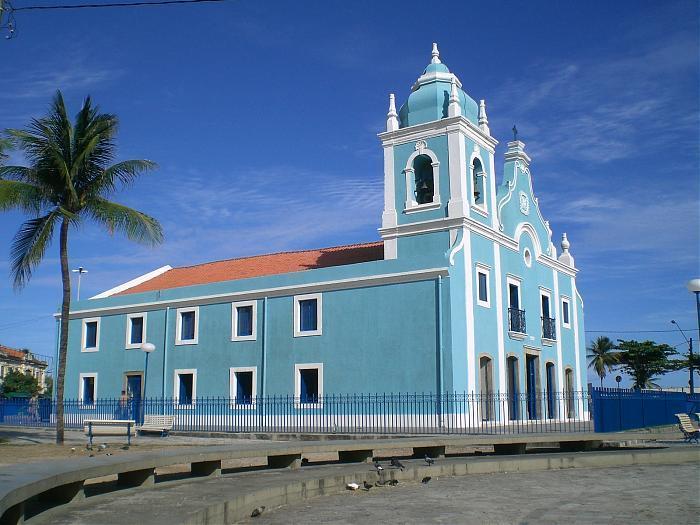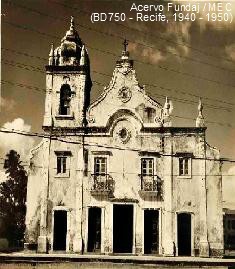History of the Church of Nossa Senhora da Boa Viagem in Recife
The Church of Our Lady of the Good Voyage, located in Pracinha de Boa Viagem in Recife, was built on the sand of the beach and the first records date back to the 17th century.

Video “Church of Our Lady of Boa Viagem in Recife

Igreja Nossa Senhora da Boa Viagem em Recife
Reform and modernisation
Around 1862, the Church of Our Lady of the Good Voyage underwent a major renovation which gave it its present appearance. The changes were significant both inside and out, with only the altar in the sacristy remaining.
“With the opening of the tram lines and Boa Viagem Avenue, the neighbourhood grew and modernised, and the church was one of the few historic buildings in the South Zone to resist modern construction.”
First records and foundation
Until the middle of the 17th century, the church of Our Lady of the Good Voyage was located in the former territory of Barreta, which corresponded to the entire coastal area that stretched from the front of Pina to the town of Candeias.
We don’t know of any precise source that gives the date of the church’s consecration. However, it is known that the church was completed in 1743.
Before 1848, the chapel belonged to the parish of Nossa Senhora da Paz, in Afogados, and it was only on 8 September of that year that it was elevated to the status of an independent parish.
The oldest document concerning the church of Our Lady of the Good Voyage is a deed dated 6 June 1707.
In it, Balthazar da Costa Passos and his wife, Ana de Araújo Costa, donated to Father Leandro Camelo a place where there was an “oratory or crib for Jesus and Mary, together with the land nearby, which was a plot of land in Barreta with a front of one hundred metres and a back of one league, from the beach to the river Jordão”.
Also by will, the donors, who were very religious, added to the chapel’s patrimony another property, next door, “with 500 hectares of land, with about thirty coconut trees, where there is a rammed earth house for sale, where Manuel Setúbal used to live”.
The image of Boa Viagem
Another piece of information from historical documents is that Father Leandro Camelo, known as a “man of great virtues”, spent everything he had to make an image of Boa Viagem in honour of the Blessed Virgin Mary and placed it in a magnificent church he built two leagues from Recife on the coast, “placing his hopes in this Lady whose care it is always to lead us to the desired port of salvation”.
Heritage and wealth
According to scholars, the Church of Nossa Senhora da Boa Viagem, although modest, was one of the temples with the highest property income in Recife during the period of colonial Brazil.
The church’s usufruct included five large estates, four small estates and twenty one-storey houses in the city, as well as a small coconut grove on the beach, donated by Father Luís Marques Teixeira with the sole obligation to withdraw from its income “the amount necessary to keep the lamp in the sanctuary of the church lit day and night”.
Reforms and structure
The major renovation of the Church of Our Lady of the Good Voyage began in 1862.
The old building was replaced by a new one with a more solemn structure. Before that, there was a small church with simple lines and a porch in front, more like one of those modest country temples.
During the renovation, the monks preserved some altars, including that in the sacristy of the church of Our Lady of the Good Voyage. Dating from 1745, this altar was carved by the master João Pereira and gilded by the artist Francisco Teixeira Ribeiro in 1772.
Influence on the region
It was undoubtedly the Capelinha de Boa Viagem that gave its name to this beautiful beach. Among the administrators, it is worth mentioning the donors of the land themselves; Balthazar Passos’ brother, Antônio da Costa Passos, and his wife, Catarina de Araujo Sampaio; the priests Luiz Marques Teixeira and Inácio Ribeiro Noia.
At the beginning of the 20th century, access to Boa Viagem was still quite difficult. In 1908, for example, there were only about 60 houses of regular construction and a chapel.
The town was only alive from September to March, when the seaside resort was popular.
At a distance of 11 km from the centre of Recife, Boa Viagem only gained momentum after the construction of the Avenida Beira-Mar, which made it possible to take the electric tram to the beach. Before that, the only public transport was a donkey-drawn tram, inaugurated in 1899.
Religious role and creation of the parish
For more than three hundred years, in addition to their work in the church, the administrators tried to participate as much as possible in the proclamation of the Gospel and the celebration of the liturgy, creating an aura of attraction for the people who passed through or lived there: boat people, fishermen, travellers and others. Above all, they were warned of the serious problems of the soul, whose vigilance could not be relaxed.
On 8 September 1948, by decree of Archbishop Miguel de Lima Valverde, the parish of Our Lady of the Good Voyage was created and the church of Nossa Senhora da Boa Viagem was raised to the status of parish church.
The first parish priest was Monsignor Romeu Vasconcelos de Sá Barreto, who stayed here from 1 January 1949 until 6 August 1967, when he died.
Publicações Relacionadas
Main historical landmarks of Pernambuco and Recife
Recife of the Dutch and Dutch Invasion in Brazil
Cais do Sertão Museum: Discover Sertanejo Culture
History of the Basilica of Our Lady of Mount Carmel in Recife
Sacred Recife and Religious Tourism in Recife, Pernambuco
Museu do Homem do Nordeste: A Cultural Journey
History of the Church of Our Lady of the Rosary of the Black Men
Igarassu: Discover the historic city of Pernambuco
Basilica of Our Lady of Penha: A Historical Overview
History and Curiosities of the Kahal Zur Israel Synagogue
History and architecture of the Palácio do Campo das Princesas in Recife
Church of Santa Teresa D'Ávila da Terceira Ordem do Carmo History
Exploring the Charm of Recife: A Historical Journey
Main Tourist Attractions in Recife You Must Visit
This post is also on:
![]() Português
Português ![]() English
English ![]() Deutsch
Deutsch ![]() Español
Español ![]() Français
Français



















